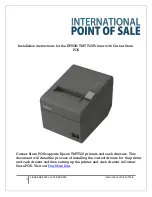
M065/M066 Correspondence White Paper Ver. 3.0
Page 31 of 58
The Secure Sockets Layer (SSL) is a commonly-used
for managing the security of a message
transmission on the Internet. SSL has recently been succeeded by Transport Layer Security (
),
which is based on SSL. SSL uses a program
layer
located between the Internet's Hypertext Transfer
Protocol (
HTTP
) and Transport Control Protocol (
TCP
)
layers. SSL is included as part of both the Microsoft and Netscape browsers and most Web server
products. Developed by Netscape, SSL also gained the support of Microsoft and other Internet
client/server
developers as well and became the de facto standard until evolving into Transport Layer
Security. The "sockets" part of the term refers to the
sockets
method of passing data back and forth
between a client and a server program in a network or between program layers in the same computer.
SSL uses the public-and-private key
encryption
system from
RSA
, which also includes the use of a
digital certificate
.
Data Encryption Standard (DES):
Data Encryption Standard (DES) is a widely-used method of data
encryption
using a private (secret)
key that was judged so difficult to break by the U.S. government that it was restricted for exportation to
other countries. There are 72,000,000,000,000,000 (72 quadrillion) or more possible encryption keys
that can be used. For each given message, the
key
is chosen at random from among this enormous
number of keys. Like other private key cryptographic methods, both the sender and the receiver must
know and use the same
private key
.
SC (Service Call):
There are 4 types of SC Conditions
Level A ; An SC condition is continually displayed on the copier operation panel. The
operator cannot reset it.
Level B ; An SC for a limit function. SC condition will be displayed only when the detected
function is selected. The operator can reset it by turning the machine off and on.
Level D ; SC condition is displayed on the copier. The operator can reset it by turning the machine off
and on.
















































